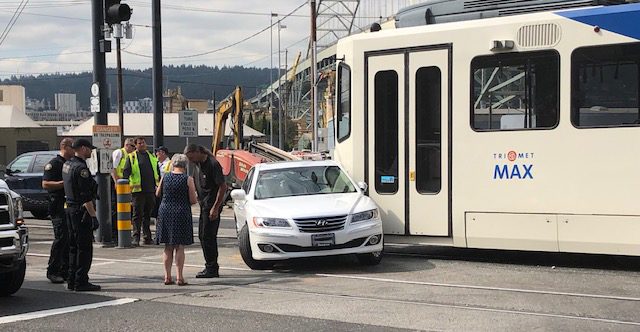Ask TriMet: How Do Service Alerts Get Posted?
If there is anything more frustrating than a delayed train or bus, it’s being in the dark about it — how long you should expect to wait and what your options are.
We put a lot of effort into making sure riders have access to timely and accurate service alerts. But did you ever wonder how information about a delay flows from the incident itself to your inbox, phone or Twitter feed?
It’s a very human process — no Service Alert Bot 3000 here. Here’s how it works, using a real example of a recent MAX Yellow Line disruption.

11:07 a.m.
Listen to the call

11:08 a.m.
The rail controller in the Operations Command Center (also known as the OCC) at our Center Street Operations Headquarters goes through safety checks with the operator: Are there any injuries*? Have you disconnected the train from the overhead electric wire that powers the train?
The controller keeps the operator on the line and continues to assess the situation. Emergency services are contacted. A rail supervisor promptly makes their way to the site of the incident.
Take a look inside our Operations Command Center.

11:09 a.m.
The threshold for posting alerts is a 10-minute delay during rush hour and about 15 minutes other times — delays shorter than this are often resolved before the alerts can be posted. It’s clear that MAX colliding with a car will result in significant delays, so the Service Information Coordinator springs into action.
The Coordinator already has our service alert dashboard up on their dedicated computer. The dashboard is a simple web-based app that lets us quickly post alerts on our website, the arrival screens on our system and the TriMet Alerts Twitter feed, and to send emails and text messages to our Service Alerts email lists.
Are you signed up for Service Alerts emails or texts?
This app gives us a lot of control over where and how to post alerts — we can put an alert on a single arrival screen on one platform or post a red alert banner on our website, and everything in between.
The Coordinator writes the alert, coordinating with the other staff in the OCC for information on how long delays will be and how long lines will be impacted.

11:13 a.m.
The Coordinator continues to monitor the situation. Using the Service Alerts system, they provide updates on details like the shuttle bus pick-up and drop-off locations, if any additional lines will be delayed, and how long delays are expected to last. Some alerts are straightforward. Others can be complicated and require frequent updates.

11:20 a.m.

11:42 a.m.

12:01 p.m.

12:09 p.m.

12:11 p.m.

12:11 p.m.

1:00 p.m.
*Note: While any collision involving a MAX train has the potential to be serious, we are grateful this one wasn’t as bad as it first appeared. One person went to the hospital, but police said it was due to a pre-existing medical condition. The two other people who were in the car were not hurt. Nobody on MAX was hurt.
Tidying MAX tracks with The Beast
TriMet’s Maintenance of Way (MOW) department manages the MAX light rail system’s overhead electric wires, signals, substations (which convert electricity from the public supply to power trains) and tracks. Since September 2022, MOW crews have saved a lot of time...
The Story of a Pageant Queen and Rail Training Supervisor 👑🚊
One of the biggest joys of the job for Rail Training Supervisor Krista Stone is pulling into a platform and seeing excited children waving at her. Girls tend to light up when they see a woman at the controls; Krista remembers one, with boundless enthusiasm, point and...
Hampton Rodriguez: The magical world of transit ticket art
For many riders, transit serves a simple purpose: trips for groceries, school, work and other destinations. But for Portland-based artist Hampton Rodriguez, transit is a conduit to inspiration for creating art. The self-described urban artist is originally from the...
Terms of Use • Privacy Policy • Rider Help Center • © TriMet





